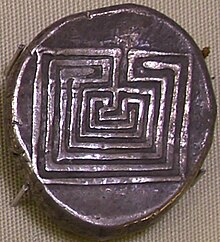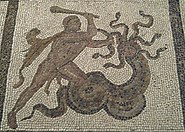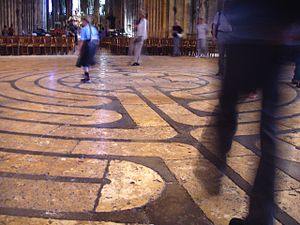Labyrinth

| Part of a series on |
| Greek mythology |
|---|
 |
| Deities |
| Heroes and heroism |
| Related |
|
|
In
Although early Cretan coins occasionally exhibit branching (multicursal) patterns,
In English, the term labyrinth is generally synonymous with maze. As a result of the long history of unicursal representation of the mythological Labyrinth, however, many contemporary scholars and enthusiasts observe a distinction between the two. In this specialized usage, maze refers to a complex branching multicursal puzzle with choices of path and direction, while a unicursal labyrinth has only a single path to the center. A labyrinth in this sense has an unambiguous route to the center and back and presents no navigational challenge.[6][7][8][9]
Unicursal labyrinths appeared as designs on
Etymology
Labyrinth is a word of
The association with "labrys" lost some traction when
Ancient labyrinths
Cretan labyrinth

When the Bronze Age site at Knossos was excavated by archaeologist Arthur Evans, the complexity of the architecture prompted him to suggest that the palace had been the Labyrinth of Daedalus. Evans found various bull motifs, including an image of a man leaping over the horns of a bull, as well as depictions of a labrys carved into the walls. On the strength of a passage in the Iliad,[23] it has been suggested that the palace was the site of a dancing-ground made for Ariadne by the craftsman Daedalus,[24][25] where young men and women, of the age of those sent to Crete as prey for the Minotaur, would dance together. By extension, in popular legend the palace is associated with the myth of the Minotaur.
In the 2000s, archaeologists explored other potential sites of the labyrinth.
The Egyptian labyrinth
In Book II of his
Pliny's Lemnian labyrinth
Pliny the Elder's Natural History (36.90) lists the legendary Smilis, reputed to be a contemporary of Daedalus, together with the historical mid-sixth-century BC architects and sculptors Rhoikos and Theodoros as two of the makers of the Lemnian labyrinth, which Andrew Stewart[33] regards as "evidently a misunderstanding of the Samian temple's location en limnais ['in the marsh']."
Pliny's Italian labyrinth
According to Pliny, the Tomb of Lars Porsena contained an underground maze. Pliny's description of the exposed portion of the tomb is intractable; Pliny, it seems clear, had not observed this structure himself, but is quoting the historian and Roman antiquarian Varro.[34]
Ancient labyrinths outside Europe
A design essentially identical to the 7-course "classical" pattern appeared in Native American culture, the
Unsubstantiated claims have been made for the early appearance of labyrinth figures in India,
Labyrinths appear in Indian manuscripts and
By the White Sea, notably on the Solovetsky Islands, there have been preserved more than 30 stone labyrinths. The most remarkable monument is the Stone labyrinths of Bolshoi Zayatsky Island – a group of some 13 stone labyrinths on 0.4 km2 area of one small island. Local archaeologists have speculated that these labyrinths may be 2,000–3,000 years old, though most researchers remain dubious.[40]
Labyrinth as pattern

The 7-course "Classical" or "Cretan" pattern known from Cretan coins (ca 400–200 BC) appears in several examples from antiquity, some perhaps as early as the late Stone Age or early Bronze Age.

The four-axis medieval patterns may have developed from the Roman model, but are more varied in how the four quadrants of the design are traced out. The Minotaur or other danger is retained in the center of several medieval examples. The Chartres pattern (named for its appearance in Chartres Cathedral) is the most common medieval design; it appears in manuscripts as early as the 9th century.
Medieval labyrinths and turf mazes

When the early humanist
Over the same general period, some 500 or more non-ecclesiastical labyrinths were constructed in Scandinavia. These labyrinths, generally in coastal areas, are marked out with stones, most often in the simple 7- or 11-course classical forms. They often have names which translate as "Troy Town." They are thought to have been constructed by fishing communities: trapping malevolent trolls or winds in the labyrinth's coils might ensure a safe fishing expedition. There are also stone labyrinths on the Isles of Scilly, although none is known to date from before the nineteenth century.
There are examples of labyrinths in many disparate cultures. The symbol has appeared in various forms and media (petroglyphs, classic-form, medieval-form, pavement, turf, and basketry) at some time throughout most parts of the world, from Native North and South America to Australia, Java, India, and Nepal.
Modern labyrinths

Starting in the late 20th century, there has been a resurgence of interest in labyrinths and a revival in labyrinth building, of both unicursal and multicursal patterns.[47] Approximately 6,000 labyrinths have been registered with the Worldwide Labyrinth Locator; these are located around the world in private properties, libraries, schools, gardens, recreational areas, as well as famous temples and cathedrals.[48][49]
The labyrinth is also treated in contemporary
Cultural meanings
One can think of labyrinths as symbolic of pilgrimage: people walking the path ascend toward salvation or enlightenment. Mystical teachings in traditions across centuries suggest that they can also be understood as coded maps of the spiritual path.[55]
Many labyrinths have been constructed recently in churches, hospitals, and parks. These are often used for contemplation; walking among the turnings, one loses track of direction and of the outside world, and thus quiets the mind.
Christian use

Labyrinths have on various occasions been used in Christian tradition as a part of worship. The earliest known example is from a fourth-century pavement at the Basilica of St Reparatus, at Orleansville, Algeria, with the words "Sancta Eclesia" [sic] at the center, though it is unclear how it might have been used in worship.
In medieval times, labyrinths began to appear on church walls and floors around 1000 AD. The most famous medieval labyrinth, with great influence on later practice, was created in Chartres Cathedral.[43]
The use of labyrinths has recently been revived in some contexts of Christian worship. Many churches in Europe and North America have constructed permanent, typically unicursal, labyrinths, or employ temporary ones (e.g., painted on canvas or outlined with candles). For example, a labyrinth was set up on the floor of St Paul's Cathedral for a week in March 2000.[56] Some conservative Christians disapprove of labyrinths, considering them pagan practices or "New Age" fads.[57]
Usage in media
Labyrinths and mazes have been embraced by the video game industry, and countless video games include such a feature. For example, the 1994 video game Marathon features many maze-like passages the player must navigate.
A number of film, game, and music creations feature labyrinths. For instance, the avant-garde multi-screen film In the Labyrinth presents a search for meaning in a symbolic modern labyrinth. The well-received 2006 film Pan's Labyrinth draws heavily upon labyrinth legend for symbolism. A magical labyrinth appears in the third episode "And The Horns of a Dilemma" of The Librarians. See Labyrinth (disambiguation) for a further list of titles.
The Argentine writer Jorge Luis Borges was entranced with the idea of the labyrinth, and used it extensively in his short stories (such as "The House of Asterion" in The Aleph). His use of it has inspired other authors (e.g. Umberto Eco's The Name of the Rose, Mark Z. Danielewski's House of Leaves). Additionally, Roger Zelazny's fantasy series The Chronicles of Amber features a labyrinth, called "the Pattern," which grants those who walk it the power to move between parallel worlds. In Rick Riordan's series Percy Jackson & the Olympians, the events of the fourth novel The Battle of the Labyrinth predominantly take place within the labyrinth of Daedalus, which has followed the heart of the West to settle beneath the United States. Ursula K. Le Guin used an underground labyrinth in the second book of her Earthsea series, The Tombs of Atuan, in which the series hero Ged is captured by the book's protagonist Tenar on his trip to the Kargish Empire – the spiritual power of the "Nameless Ones" is vested at least in part in the labyrinth. Australian author Sara Douglass incorporated some labyrinthine ideas in her series The Troy Game, in which the Labyrinth on Crete is one of several in the ancient world, created with the cities as a source of magical power. Lawrence Durrell's The Dark Labyrinth depicts travelers trapped underground in Crete. Because a labyrinth can serve as a metaphor for situations that are difficult to be extricated from, Octavio Paz titled his book on Mexican identity The Labyrinth of Solitude, describing the Mexican condition as orphaned and lost.
See also
Notes
- ^ Ancient: [labýrintʰos], Modern: [laˈvirinθos]
- ^ Doob 1992, p. 36
- ^ Kern, Through the Labyrinth, 2000, item 43, p. 53.
- ^ Kern, Through the Labyrinth, 2000, item 50, p. 54.
- ^ Penelope Reed Doob, The Idea of the Labyrinth, pp. 40–41.
- ISBN 0375423060.
- ^ Kern, Through the Labyrinth, p. 23.
- ^ The usage restricting maze to patterns that involve choices of path is mentioned by Matthews (p. 2–3) as early as 1922, though he does not find the distinction useful and does not follow it himself.
- ^ Jeff Saward. "Mazes or Labyrinths?" (PDF). Labyrinthos. Retrieved 28 December 2017.
- ^ "About Labyrinths". The Labyrinth Society. Retrieved 18 September 2015.
- ISBN 0375423060.
- ^ Mayer, "Maximilian (1892). "Mykenische Beiträge. II. Zur mykenischen Tracht und Kultur". Jahrbuch des Kaiserlich deutschen archäologischen Instituts. VII: 191.
- ^ Λυδοὶ γάρ 'λάβρυν' τὸν πέλεκυν ὀνομάζουσι, Plutarch, Greek Questions, 45 2.302a.
- ^ a b The Oxford Classical Dictionary. Oxford University Press p.116. Oxford Classical Dictionary
- (p. 273).
- ^ Martin Nilsson (1967): Die Geschichte der Griechische Religion. C.F.Beck Verlag Vol I, p. 277
- ^ Raymoure, K.A. "da-pu2-ri-to-jo". Minoan Linear A & Mycenaean Linear B. Deaditerranean.
- ^ Stephanie Lynn Buden. The Ancient Greeks. An introduction. Oxford University Press.p. 227 [1]
- ^ a b Sarullo, Giulia (2008). "The Cretan Labyrinth: Palace or Cave?". Caerdroia. 37: 31–40.
- ^ Aspesi, Francesco (1996). "Greco labyrinthos, ebraico debîr". KRHTH TIS GAI ESTI: Studi e ricerche intorno ai testi minoici. Roma: Il Calamo.
- ^ Aspesi, Francesco (1996). "Lineare A (-)da-pu2-re: un'ipostesi". KRHTH TIS GAI ESTI: Studi e ricerche intorno ai testi minoici. Roma: Il Calamo.
- ISBN 3791321447.
- ISBN 978-90-04-17418-4.
- ^ Homer. "Iliad". Perseus Digital Library. Tufts University. xviii.590–3.
- S2CID 161753794.
- ^ "Furthermore he wrought a green, like that which Daedalus once made in Cnossus for lovely Ariadne. Hereon there danced youths and maidens whom all would woo, with their hands on one another's wrists. The maidens wore robes of light linen, and the youths well woven shirts that were slightly oiled. There was a bard also to sing to them and play his lyre, while two tumblers went about performing in the midst of them when the man struck up with his tune."
- The Iliad: Transl, by Samuel Butler:[2]
- ^ a b Steve Connor (16 October 2009). "Has the original Labyrinth been found?". The Independent.
- ^ National Geographic Channel: The Holy Grail (and the Minotaur) Archived 1 January 2011 at the Wayback Machine
- The Histories, translated by Aubrey de Sélincourt, Book II, pp. 160–161.
- ^ Kern 2000, p. 59.
- ISBN 9780802117038.
- ISBN 9780500285473.
- ^ Matthews, p. 13.
- ^ Andrew Stewart, One Hundred Greek Sculptors: Their Careers and Extant Works, "Smilis."
- ^ Pliny the Elder, Natural History, xxxvi.91–92.
- ISBN 1579905390.
- ^ a b Saward, Labyrinths and Mazes, p. 60.
- ^ "Festival on Labyrinth and Symmetry". 9th ISIS Congress. 9 September 2013.
- ^ Saward, Labyrinths and Mazes, pp. 60–61.
- ^ Al-Beruni, India, (c. 1030 AD), Edward C. Sachau (translator), Kegan Paul, Trench, Trübner & Co, London, 1910 Online version from Columbia University Libraries (Retrieved 5 December 2009)
- ^ Saward, Labyrinths and Mazes, pp. 148–149.
- ^ "Labyrinthos Archive – The First Labyrinths". www.labyrinthos.net. Retrieved 10 January 2020.
- ^ "quod nunc Harena dicitur": Roberto Weiss, The Renaissance Discovery of Classical Antiquity 1969:25.
- ^ ISBN 978-3-7913-2144-8.
- ^ Herbermann, Charles, ed. (1913). . Catholic Encyclopedia. New York: Robert Appleton Company.
- ^ ISBN 978-0-674-00503-7.
- JSTOR 1260358.
- ISBN 1579905390.
- ^ Bliss, Laura (29 July 2020). "The Pandemic-Era Appeal of Getting Lost in a Labyrinth". Bloomberg News. Retrieved 30 July 2020.
- ^ "Welcome to the World-Wide Labyrinth Locator!". World-Wide Labyrinth Locator. Retrieved 23 November 2021.
- ^ Davide Tonato, Labyrinth of Transformations (edited by Renzo Margonari), Grafiche Aurora, Verona 1988
- ^ Brown, Mark (7 February 2013). "Tube celebrates 150th birthday with labyrinth art project". The Guardian. Retrieved 9 February 2013.
- ISBN 9781908970169. Retrieved 7 January 2017.
- ^ Ruth Mellinkoff, Averting Demons, 2004, Vol. 2, p. 164.
- ^ a b
Schuster, Carl, & Edmund Carpenter (1996). Patterns that Connect: Social Symbolism in Ancient & Tribal Art. Harry N. Abrams. p. 307. ISBN 978-0-8109-6326-9.)
{{cite book}}: CS1 maint: multiple names: authors list (link - ISBN 978-0983303800.
- ^ Ian Tarrant and Sally Dakin, Labyrinths and Prayer Stations, p 6.
- ^ Mark Tooley (September 2000). "Maze Craze". Touchstone Magazine. The Fellowship of St. James. Retrieved 29 December 2016.
References
- Hermann Kern, Through the Labyrinth, ed. Robert Ferré and Jeff Saward, Prestel, 2000, ISBN 3-7913-2144-7. (This is an English translation of Kern's original German monograph Labyrinthe published by Prestel in 1982.)
- Lauren Artress, Walking a Sacred Path: Rediscovering the Labyrinth as a Spiritual Practice, Penguin Books, 1995, ISBN 1-57322-007-8.
- Lauren Artress, The Sacred Path Companion: A Guide to Walking the Labyrinth to Heal and Transform, Penguin Books, 2006, ISBN 1-59448-182-2.
- Doob, Penelope Reed (1992). The Idea of the Labyrinth: from Classical Antiquity through the Middle Ages. Ithaca: Cornell University Press. ISBN 0-80142-393-7.
- The Histories, Newly translated and with an introduction by Aubrey de Sélincourt, Harmondsworth, England, Penguin Books, 1965.
- Karl Kerenyi, Dionysos: Archetypal Image of Indestructible Life, Princeton University Press, 1976.
- Helmut Jaskolski, The Labyrinth: Symbol of Fear, Rebirth and Liberation, Shambala, 1997.
- Adrian Fisher & Georg Gerster, The Art of the Maze, Weidenfeld & Nicolson, 1990. ISBN 0-297-83027-9.
- Jeff Saward, Labyrinths and Mazes, Gaia Books Ltd, 2003, ISBN 1-85675-183-X.
- Jeff Saward, Magical Paths, Mitchell Beazley, 2002, ISBN 1-84000-573-4.
- W. H. Matthews, Mazes and Labyrinths: Their History and Development, Longmans, Green & Co., 1922. Includes bibliography. Dover Publications reprint, 1970, ISBN 0-486-22614-X.
- Andrew Stewart, One Hundred Greek Sculptors: Their Careers and Extant Works.
- Henning Eichberg, "Racing in the labyrinth? About some inner contradictions of running." In: Athletics, Society & Identity. Imeros, Journal for Culture and Technology, 5 (2005): 1. Athen: Foundation of the Hellenic World, 169–192.
- Edward Hays, The Lenten Labyrinth: Daily Reflections for the Journey of Lent, Forest of Peace Publishing, 1994.
- Carl Schuster and Edmund Carpenter, Patterns that Connect: Social Symbolism in Ancient & Tribal Art, Harry N. Abrams, NY, 1996.
- Ettore Selli, Labirinti Vegetali, la guida completa alle architetture verdi dei cinque continenti, Ed. Pendragon, 2020; ISBN 9788833642222
External links
- Saward, Jeff (2012). "Labyrinthos". Labyrinthos.net.
- The Labyrinth Society
- World-Wide Labyrinth Locator, an international directory
- Veriditas – Spiritual labyrinth organization founded by Lauren Artress.
- Sunysb.edu, Through Mazes to Mathematics, Exposition by Tony Phillips
- Astrolog.org, Maze classification, Extensive classification of labyrinths and algorithms to solve them.
- Irrgartenwelt.de, Lars O. Heintel's collection of handdrawn labyrinths and mazes
- Begehbare-labyrinthe.de Website (in German) with diagrams and photos of virtually all the public labyrinths in Germany.
- Mymaze.de, German website (in German) and Mymaze.de (in English) with descriptions, animations, links, and especially photos of (mostly European) labyrinths.
- Indigogroup.co.uk, British turf labyrinths by Marilyn Clark. Photos and descriptions of the surviving historical turf mazes in Britain.
- Theedkins.co.uk, Jo Edkins's Maze Page, an early website providing a clear overview of the territory and suggestions for further study.
- Gottesformel.ch, "Die Kretische Labyrinth-Höhle" by Thomas M. Waldmann, rev. 2009 (in German, English, French, and Greek). Description of a labyrinthine artificial cave system near Gortyn, Crete, widely considered the original labyrinth on Crete.
- Spiralzoom.com an educational website about the science of pattern formation, spirals in nature, and spirals in the mythic imagination & labyrinths.
- Sanu.ac.rs, "The Geometry of History," Tessa Morrison, University of Newcastle, Australia. An attempt to extend Phillips's topological classification to more general unicursal labyrinths.
- Labyrinth of Egypt – Archaeological site reconstruction and 3D diagrams based on the writings of Herodotus and Strabo.
- Report of expedition to Hawara in 2008 in search of the lost Egyptian Labyrinth of Herodotus.
- Video and annotation on labyrinths
